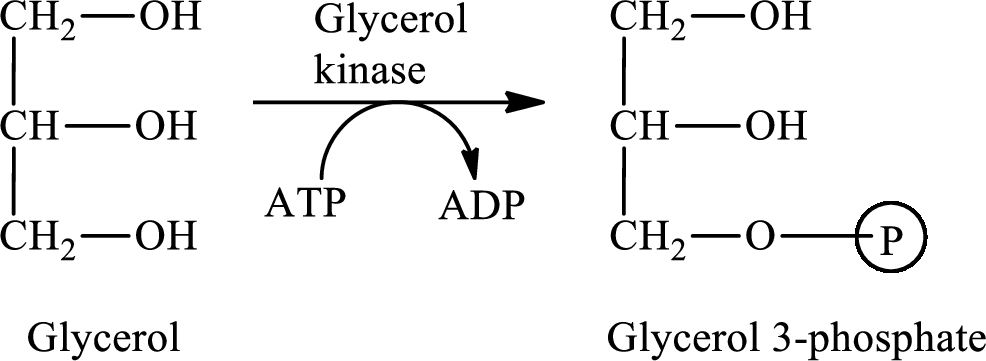
Concept explainers
(a)
Interpretation: To determine the step of glycerol
Concept introduction: Triacylglycerol mobilization is an ongoing process in which triacylglycerols that are stored in the adipose tissue are hydrolyzed. Fatty acids and glycerol are the products of triacylglycerol mobilization. The products are released into the bloodstream.
After entering the bloodstream, the glycerol travels to the kidneys or liver. The first stage of glycerol metabolism occurs in the liver or kidney. The first stage of glycerol metabolism is a two-step process. After the first stage, the remaining stages of glycerol metabolism are the same as glucose pathways. The overall equation for glycerol metabolism is as follows:
Nicotinamide adenine dinucleotide is associated with the
(a)
Answer to Problem 14.20EP
The oxidizing agent
Explanation of Solution
The first stage of glycerol metabolism is a two-step process. In step 1,

Here, represents
represents
In step 2 of glycerol metabolism,
(b)
Interpretation: To determine the step of glycerol metabolism in which ADP is produced.
Concept introduction: Triacylglycerol mobilization is an ongoing process in which triacylglycerols that are stored in the adipose tissue are hydrolyzed. Fatty acids and glycerol are the products of triacylglycerol mobilization. The products are released into the bloodstream.
After entering the bloodstream, the glycerol travels to the kidneys or liver. The first stage of glycerol metabolism occurs in the liver or kidney. The first stage of glycerol metabolism is a two-step process. After the first stage, the remaining stages of glycerol metabolism are the same as glucose pathways. The overall equation for glycerol metabolism is as follows:
Adenosine triphosphate (ATP) is a triphosphate
(b)
Answer to Problem 14.20EP
ADP is produced in step 1 of glycerol metabolism.
Explanation of Solution
The first stage of glycerol metabolism is a two-step process. The first step of glycerol metabolism requires energy that is provided by ATP. In this step, glycerol is converted to
The

Here, represents
represents
Therefore, ATP is consumed in step 1 which is further converted to ADP in glycerol metabolism
(c)
Interpretation: To determine the step of glycerol metabolism in which
Concept introduction: Triacylglycerol mobilization is an ongoing process in which triacylglycerols that are stored in the adipose tissue are hydrolyzed. Fatty acids and glycerol are the products of triacylglycerol mobilization. The products are released into the bloodstream.
After entering the bloodstream, the glycerol travels to the kidneys or liver. The first stage of glycerol metabolism occurs in the liver or kidney. The first stage of glycerol metabolism is a two-step process. After the first stage, the remaining stages of glycerol metabolism are the same as glucose pathways. The overall equation for glycerol metabolism is as follows:
A reactant is defined as the substance that is initially present in the chemical reaction and gets consumed to form a new substance.
(c)
Answer to Problem 14.20EP
Explanation of Solution
The first stage of glycerol metabolism is a two-step process. In step 1,

Here, represents
represents
Therefore,
(d)
Interpretation: To determine the step of glycerol metabolism in which secondary alcohol is oxidized.
Concept introduction: Triacylglycerol mobilization is an ongoing process in which triacylglycerols that are stored in the adipose tissue are hydrolyzed. Fatty acids and glycerol are the products of triacylglycerol mobilization. The products are released into the bloodstream.
After entering the bloodstream, the glycerol travels to the kidneys or liver. The first stage of glycerol metabolism occurs in the liver or kidney. The first stage of glycerol metabolism is a two-step process. After the first stage, the remaining stages of glycerol metabolism are the same as glucose pathways. The overall equation for glycerol metabolism is as follows:
In the secondary alcohol, the carbon atom of the hydroxyl group

Here, R and
(d)
Answer to Problem 14.20EP
Secondary alcohol is oxidized in step 2 of glycerol metabolism.
Explanation of Solution
The first stage of glycerol metabolism is a two-step process. In step 1,

Here, represents
represents
Want to see more full solutions like this?
Chapter 14 Solutions
Organic And Biological Chemistry
 Chemistry for Today: General, Organic, and Bioche...ChemistryISBN:9781305960060Author:Spencer L. Seager, Michael R. Slabaugh, Maren S. HansenPublisher:Cengage Learning
Chemistry for Today: General, Organic, and Bioche...ChemistryISBN:9781305960060Author:Spencer L. Seager, Michael R. Slabaugh, Maren S. HansenPublisher:Cengage Learning Organic And Biological ChemistryChemistryISBN:9781305081079Author:STOKER, H. Stephen (howard Stephen)Publisher:Cengage Learning,
Organic And Biological ChemistryChemistryISBN:9781305081079Author:STOKER, H. Stephen (howard Stephen)Publisher:Cengage Learning, General, Organic, and Biological ChemistryChemistryISBN:9781285853918Author:H. Stephen StokerPublisher:Cengage Learning
General, Organic, and Biological ChemistryChemistryISBN:9781285853918Author:H. Stephen StokerPublisher:Cengage Learning Introduction to General, Organic and BiochemistryChemistryISBN:9781285869759Author:Frederick A. Bettelheim, William H. Brown, Mary K. Campbell, Shawn O. Farrell, Omar TorresPublisher:Cengage Learning
Introduction to General, Organic and BiochemistryChemistryISBN:9781285869759Author:Frederick A. Bettelheim, William H. Brown, Mary K. Campbell, Shawn O. Farrell, Omar TorresPublisher:Cengage Learning Chemistry In FocusChemistryISBN:9781305084476Author:Tro, Nivaldo J., Neu, Don.Publisher:Cengage Learning
Chemistry In FocusChemistryISBN:9781305084476Author:Tro, Nivaldo J., Neu, Don.Publisher:Cengage Learning




